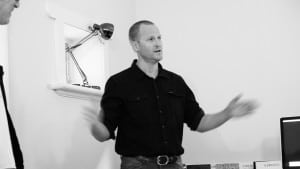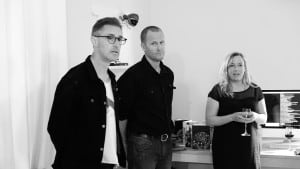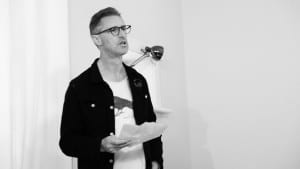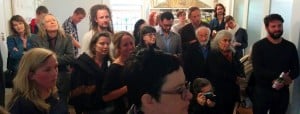You may be wondering why a jaded hack like me is speaking at the launch of Garland tonight rather than a luminary of the world of craft. Certainly those at my school who tried to din pottery and woodwork into me would be surprised by my role. My gift then was for throwing a vast quantity of clay onto the wheel with an elaborate and ornate amphora in mind, which over succeeding weeks would be reduced to an ashtray. Ashtrays – there were many ashtrays. I also made a chopping board for my mother, starting with a flat piece of wood that by the time I had finished with it rocked like a cradle. This she loyally used with the effect tht bread slices in our household were always subtly corrugated.
Anyway, call it the allure of that which one cannot do oneself. I have no great gift for much, but I’m impressed with those who do. I married a craft person. My wife works in cold glass, which is scattered through our house. And that is indirectly why I’m here. When we were first going out, we used to visit Craft Victoria quite a bit. I even used to go on my own – when I didn’t like the work, I could always get a laugh out of the artist statements. One day I was coming in as Damien Wright was going out. I knew Damien vaguely through his wife Clare, a historian, so we stopped to chat, and I asked what he was working on. Half an hour later I was still there. Those of you who know Damien may recognise the scenario.
I didn’t remain simply out of politeness. Damien is a wonderfully gifted expositor, with a way of explaining his work that makes you question your whole relationship to the world of objects – he leaves you feeling slightly shamed for not demanding a bit more of them. I’ve sat through numberless soundalike sessions at writers festivals with writers purporting to reveal the secrets or writing and words, and often found them painfully inarticulate on the subject. Damien’s extemporaneous exposition of his work was so engaging, so persuasive, that I decided then and there I’d have to write about him and it, which I did at some length and in detail.
So much modern work, I had cause to reflect, is based on the idea of doing a variety of small things to a passable standard within a predetermined amount of time, and diffusing responsibility for a whole when it eventually proves to be…well, shit. In this context, craftsmanship might be felt an act of true economic subversion, the daring ethic of dwelling on a task for a long time, going deeply into it, accepting the credit or blame for the whole, but also seeking always to do it better. The preferred role model of modern work is the management consultant, who swoops in and out, and whose very pride lies in his lack of particular expertise, his remaining above the fray of the material world, presenting an image of soaring freedom, but actually more passive, more dependent, more helpless. To achieve profound manual competence, by comparison, is to pursue true agency, autonomy, mastery. It’s a dangerous idea, an act of resistance, in a world that presents instability as opportunity, insecurity as progress.
A further reason Damien’s work spoke to me, I think, was the vague unease I experience with a lot of contemporary art. I was recently reading Gerald Murnane’s memoir in which he disclosed a deep and abiding dislike of movies – the too-complicated plots, the too-calculated dialogue, all the soulful staring. While I don’t share that sensibility, I recognised the self-consciousness he objected to in my encounters in modern galleries. I have the disquieting sense of a racket at work, a clambering for recognition, a conversation I’ll only ever be on the fringes of, a hierarchy I’m being coerced into deferring to in the interests of a privileged elite, a bit of a Ponzi scheme, actually – exclusive, meretricious, self-regarding, and maybe a bit corrupt.
The beauty that’s useable, by contrast, that suggests discrimination in the choice of material, skill in the conception and detail, patience in the making and finishing, and offers kinaesthetic pleasure in the handling puts us in touch with our common humanity. Very common, in fact. A few years ago I was asked to review Walter Isaacson’s life of Steve Jobs – a bad book about an unpleasant man who made an obscene fortune from mass producing sterile fetish objects as far as I was concerned, which is what I said. Yet I was struck by his gimlet eye for detail, such as his belief in the universality of the rounded-corner rectangle, and by the snatches of dialogue from his design conferences like: ‘It needs to be more curvaceous. The radius of the first chamfer needs to be bigger, and I don’t like the size of the bevel.’ Though revered as a technologist, Jobs’ success concerns more than functionality and fashion – he had an undeniable grasp of the enchantment that lurks in everyone with the ideal shape and the just-right
I’ve read Garland with enjoyment. It’s attractive and accessible and deserves a wide audience. It’s a craft object in its own right, of course – not least, perhaps, in that its makers will not be retiring on the proceeds. Perhaps its content should be thought of in like spirit. Use of language is itself a craft, patiently acquired, always improveable, balancing convention and experimentation, explanation and evocation. I hope that the search for a voice and tone that complements and illuminates the subjects and objects that Garland exists to celebrate will be long and rewarding. Congratulations to Kevin, Damien and Olivia Pintos-Lopez, Garland’s editorial board on a worthy enterprise. The beat poet Lawrence Ferlinghetti famously urged: ‘Fuck art, let’s dance’; well, fuck art, let’s craft.
Gideon Haig
Gideon Haig is an author of many books and articles, including The Pursuit of Usable Beauty which as inspired the idea of the Quarterly Essay. He spoke at the launch of the first issue of Garland, 11 December 2015.






